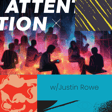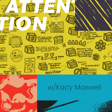Become a Creator today!Start creating today - Share your story with the world!
Start for free
00:00:00
00:00:01

Two Marketers Talk Media & Audience Growth Trends w/Justin Schmidt
In this episode, Dan Sanchez talks to Justin Schmidt who is the VP of Marketing at Capacity.
They discuss:
- The emerging trend of B2B companies actually becoming media companies
- Dan pitched his idea of having two separate websites to Justin
- Justin also shared some fantastic nuggets on how to convert more traffic
They discuss:
- The emerging trend of B2B companies actually becoming media companies
- Dan pitched his idea of having two separate websites to Justin
- Justin also shared some fantastic nuggets on how to convert more traffic
Transcript
Introduction to B2B Media Companies
00:00:03
Speaker
Welcome back to the Attention Podcast, where you learn how to gain and retain the attention of your buyers to grow an audience. I'm Dan Sanchez with Sweetfish, and today I talk to Justin Schmidt, who is the VP of Marketing at Capacity. In this episode, we talk about the emerging trend of B2B companies actually becoming media companies. I pitched him on the idea of having two separate websites, and he shared some fantastic nuggets about how to convert more traffic.
00:00:31
Speaker
So let's get into it. Justin, welcome to the show. Hi, Dan. Thanks for having me.
Companies as Publishers: Shifting Focus
00:00:40
Speaker
So I have to start with this question. What does it mean for companies to act more like publishing companies today? It's a good question. So when you think about a publisher, and this could be anywhere from New York Times to a mommy blog with 500 readers a month, it's sort of the same idea. You are competing for attention.
00:01:01
Speaker
your conversion is amount of attention. And more often than not, you're monetizing with ads, or maybe you have an athletic type subscription model, or maybe you got affiliate revenue. In any event, you're monetizing with a very short conversion cycle, or in some cases, your conversion happens at the speed of however long it takes the ad to render from wherever Google's server is to the page of the person that's viewing your content.
00:01:31
Speaker
So under the auspice of attention and monetizing attention, you need to construct your audience development, your content, your content operations, and therefore the scale and pace of your content needs to be built around capturing attention and only focusing on attention as opposed to what we in the B2B space have to sort of navigate, which is
Creative Freedom in Content Creation
00:01:55
Speaker
you know, capturing top funnel attention and moving that into mid funnel consideration and then moving mid funnel consideration down into the actual purchase decision or filling out the form and going through the sales cycle, which then has its own funnel that has to go through, right? So you just view content a little differently. The other thing I think that comes into play when acting like a publisher is publishing has the
00:02:21
Speaker
gift, I will call it, of being able to explore topics and angles and do it in a way where you can use voice that might not necessarily always land on brand for a direct brand or software company. And that gives a lot of freedom and I think you sort of put yourself in a much more creative space. So combine it with
00:02:47
Speaker
Let's optimize for attention and consumption and worry about pulling that through the funnel later versus the other end of this, which is you tend to have more bandwidth and more green space with how you're going to represent your point of view, what topics you're going to cover, how you're going to write, what mediums you're going to use, et cetera, when you're sort of operating in the attention economy versus the conversion economy, so to speak.
Realistic Content Expectations
00:03:14
Speaker
So there's two things that come to mind after you said that. One is it seems like before the way most people do it, people are essentially trying to get too much out of one piece of content.
00:03:25
Speaker
You put out a blog post and you hope that things not only going to get their attention, it's going to nurture the relationship, get them to take a sales conversion step and maybe even shoot them down the sales funnel. It's essentially expecting too much for a piece of content, right? What you're saying is, hey, just let the content get their attention. You could do the other stuff later. Sometimes all you need to do is answer a question, right? Yeah.
00:03:47
Speaker
Sometimes all you need to do is provide a little bit of insight and if you're savvy and you've got your product market fit dialed in, you've got your all your sales process and funnel optimization after the form fill dialed in, you can take the approach of spending a lot of effort on top funnel.
00:04:07
Speaker
and then building retargeting audiences and lookalikes and all the sort of advanced demand gen stuff to then pull in and capture that demand, you know, create demand versus capture demand. And you can kind of operate that way, but you're right that there is a bit of a tendency in B2B and listen, we're guilty of this too. It's just you're sort of like, the incentives are aligned to do this, where you just try to make
00:04:34
Speaker
everything be lead capture all the time and then you rely purely on sort of post lead capture nurture to create the relationship.
Brand Separation for Media Ventures
00:04:45
Speaker
The other thing I wanted to mention was would you recommend companies separating out like a separate brand for media? Oh man, this is such a good question. This is such a good question. And it's one that is becoming increasingly common, right? So HubSpot buys the hustle.
00:05:05
Speaker
Hrefs just bought Backlinko. You see a lot of brands, big ones, picking up these small sort of niche publishers. PubSpot's another great example with their podcast network, right? The MarTech podcast with Ben Shapiro. Not that Ben Shapiro, different Ben Shapiro.
00:05:22
Speaker
great podcast absolutely love it he's part of the hub spot podcast network right now and it makes a ton of sense for hub spot to own that audience like it's a it's a no-brainer partnership but yes I think the answer is should you dedicate resources to
00:05:42
Speaker
thinking like a publisher and building media brand absolutely should that be a different brand than your sort of main software brand so to speak if we're leaving this in a b2b perspective i don't know the answer to that it seems that more often than not that's the case you see this with communities right give you a great example there's a revenue operations change management
00:06:03
Speaker
sort of intelligence application out there called sonar great product they also have a community wizard of ops for sales ops and marketing ops people that's very very very active very very very rich those are clearly two different brands right so whether or not you do it in the same brand and you want to try to build like the branded house versus the house of brands i think that's gonna depend on your audience that's gonna depend on
00:06:27
Speaker
nature of your sales cycle that's going to depend on the market you're in. So it's a hard question for me to answer sort of with a direct yes or no because I'm seeing it both ways.
Building vs Acquiring Audiences
00:06:38
Speaker
Let me throw an idea I've had out to you and see how you react to it. Let's do it. Something I've been thinking a lot about because obviously I think most marketers are facing this the audience thing is why I'm even starting the podcast because it was like clearly this is becoming a thing, right? People are paying lots of money to acquire audiences now.
00:06:54
Speaker
And then part of me is like, as a guy who does, I do audience growth consulting for many podcast owners in Sweetfish. I'm like, why not just build bigger audiences rather than acquire them? Why don't more people just build them in house and build them in a way as if they're building a separate media company and then they just advertise their own stuff in it rather than paying through the nose to get on somebody else's network, right? But I think people are just afraid to separate it out. But I think it needs to be separate purely from a positioning standpoint.
00:07:22
Speaker
your company has to be positioned a certain way in order to help people connect with what the product is, right? Correct. But the media should probably be broader to be the source of inspiration for your audience, right? Which is going to be broader than the positioning for your company. It should have a niche positioning unless you're creating a new category. And even that's going to be a future niche positioning compared to all the things your buyers want to hear about.
00:07:47
Speaker
But you could talk to all the things your buyers want to hear about. You could interview the panels of all the experts in that thing. So why wouldn't you build a separate brand, position it more broad? That way, your product and company can be positioned and the website can be optimized for conversions. Meanwhile, your media company can be optimized for audience growth and subscription.
Audience and Media Strategies
00:08:10
Speaker
Yeah, if you're capitalized in such a way where you can make that investment knowing that the time horizon on the return is going to be longer, then yes, it probably is the better the better play to make to build it as a separate brand. I think a lot of the reason you're seeing these acquisitions is look like pub spots got a
00:08:29
Speaker
a few money that they can go out and deploy on whatever they want, right? So they do. It's interesting when you think about audience though, because this is something I dealt with a lot in my prior life as I ran marketing and publishing for a very, very large conglomerate of web properties that didn't have the strongest brand, but from a traffic generation and audience development perspective, we were top 1%.
00:08:56
Speaker
The concept here is like the rent versus buy and sort of trying to, for lack of a better word, wash one audience into yours, convert that audience into yours, launder that audience into yours, if you will.
00:09:11
Speaker
And I think there is a good opportunity in the B2B space anyway to start leveraging some of these communities and audiences. I mean, this is niche publishing, right? The trade publications have existed forever. There's a difference now in that I think as people switch to more like community management and
00:09:35
Speaker
more sort of multi-channel engagement and sort of like the bi-directional communication that a publishing brand has with their audience at this point. I think that the script is slightly changed, but the end goal with trade publications has sort of always been to build a niche audience, then advertisers sort of rent access to that audience, right?
00:09:53
Speaker
The difference is, for the longest time, for the absolute longest time, the trade publications advertising base wasn't also trying to build an audience, right? They were just trying to generate revenue. Well, that has shifted a little bit. It's going to be really interesting just as someone who likes this space to watch how that's going to evolve over time, you know?
00:10:13
Speaker
Just kind of reacting to what you said and thinking about it, I am in most mostly in agreement with you that it probably should be a separate brand, but I think there's going to be a real effort on marketing content teams, you know PR community, whoever it is in the in the business that that's gonna be responsible for this thing.
00:10:34
Speaker
to make sure everyone understands this is a long-term investment. If we build a great community, we can't just shove our product on that community's throat every chance we get. We're going to really have to be a very important part of that community and letting that community grow and flourish, otherwise it's not going to work. Audience building is effectively community building, so I think it's good to conflate the two. A separate brand does make a lot of sense if you can do it.
00:11:02
Speaker
I think a lot more companies are going to be doing it. I think they're going to have to, only because the competition from the new companies that haven't even started yet, who literally started with an audience. First, they built the audience and took one, two years to do, even a small audience. Should a B2B brand can monetize an audience like 10 times better than like the New York Times can monetize its audience. That's exactly right.
00:11:25
Speaker
I was amazed when I looked at the revenue for
Monetization Models in Media
00:11:28
Speaker
the New York Times, I'm like, that's it? Gosh, I mean, it's a big company, but it's not that big. Well, it's interesting you say this. WebMD, not that big. Walgreens, like a WebMD's full operating budget is like a tiny percentage of Walgreens' total marketing budget.
00:11:43
Speaker
Exactly. And think about just the multiples of these things, right? So New York Times is the bell of the ball when it comes to subscription revenue-based publishing businesses. And they trade at what? Two and a half, three times revenue. Buzzfeed, which is arguably the best audience generation tool, you know, Jonah Peretti gets a ton of credit for how much he understands media in the modern world.
00:12:05
Speaker
That's the the godfather of the sort of modern media company and they trade at what like a little over one times revenue You know what? I mean like it's compare that with the multiples that you know sass companies get and it's it's it's just not the same ballpark, but you bring up a great point in that if the whole marketing cycle is creating demand and capturing demand
00:12:28
Speaker
And you get good at creating demand, and you get good at developing an audience. It does beg the question if, I don't know, I think if I can marketing, there's like demand curve in the customer support space, you've got support driven. It is an interesting question if one day those guys don't think like, well, either, you know, I'm sure they're getting some corporate dev people reaching out to them about acquiring their businesses.
00:12:56
Speaker
It does beg a question, too, if they should start looking into some of their own product expansion and see if they could leverage that into a SaaS company. It's a really interesting thing you bring up there, Dan. Are we going to see the audience vehicle launch its own SaaS product? It seems like it's inevitable that it's going to happen with one of these guys. I think you see someone like the bigger YouTuber starting to experiment with this stuff now. Hence, MrBeast is launching his own restaurant, Beastburger.
00:13:25
Speaker
It's making lots of money. Of course, he's deployed it a very different way rather than brick and mortar. It's the other way around. But I know another, there's like, I just moved to Nashville and there's like a mom blogger in the area called the Trim Healthy Mama or something like that. And I was amazed. My friend works there and he's, I was like, Oh yeah. So like how much revenue does it do? I was thinking like a few million, you know, cause it's got a million audience, audience of like a million or two.
00:13:49
Speaker
He's like, no, no, no, it's 200K. I'm like, in revenue? I was like, the mom blog? He's like, yeah, we have like 200 employees. I'm like, oh, hello. Like the audience has more weight and leverage than I think people realize. And I think right now people are getting the hustle on the morning brew for a steal. I still think Joe Rogan was probably a steal for Spotify considering they've overtaken Apple now in the most used podcast app because of stuff like that.
00:14:18
Speaker
I don't know. We'll just see. I mean, I started the whole podcast on the premise that this is going to be a bigger thing, but we'll see how it actually plays out. People thought digital magazines were going to be a thing like six years ago, too. I don't know if you remember some of those things. You know what's funny about the digital magazine things? I always think about this. I used to use this example a lot when I talked in
00:14:40
Speaker
the publishing circles I used to run in. Pinterest started as a aggregator and basically a digitizer of catalogs. Their whole original business was to scan catalogs and make them digitally available and browse.
00:14:56
Speaker
and like issue. Yeah, exactly. And that sort of turned into the concept of Pinterest. And now Pinterest is sort of turned into more or less what they originally envisioned building, just instead of like sucking in catalogs that it's just users are creating and advertisers are creating the merchandising of these things. There is a really strong desire in all publishing and media companies to diversify away from ad revenue because, you know, it's all Google and Facebook, the CPMs are
00:15:25
Speaker
Not great. And you have to go out and get direct deals and maybe you have to go out and get programmatic direct, or maybe you go out and try to build affiliate revenue. Well, affiliate revenue, if you're going to do Amazon associates, you know, you get paid.
00:15:36
Speaker
a pittance for all the traffic you send over. So then you look into these like super affiliate type things. And Red Ventures is a great example of a publishing driven company that does a lot. I mean, you go look it up. They're very good business. But they're dealing with much higher average order value type things that they typically run through. And like Go Figure, when you talk about high average order value, like B2B SaaS companies have
00:16:01
Speaker
the ultimate luxury in that regard. So the same principles that, you know, a product aggregator can leverage into Amazon Associates affiliate revenue is only a hop or two away from, I don't know, caring.com to use a Red Ventures property into, you know, selling leads to nursing homes and memory care facilities. Obviously, that's a much higher order value than whatever the average Amazon card is.
00:16:27
Speaker
And then the step from the caring.com to HubSpot again, like it's only from a content and sort of audience development play. It's only a few steps different, but you're talking like massively different order values or average order values.
Capacity's Approach to Audience Development
00:16:40
Speaker
They're still right. So you're right to start this podcast now and we as marketers are absolutely
00:16:49
Speaker
incentivize to get our shit together on this as fast as we can. And I agree with your optimism and worldview that this is going to be a major part of the marketing mix going forward.
00:17:02
Speaker
We'll see. You can only hope, right? Hindsight will always be 20-20 to see how this played out. I usually find that it's like, yes and, and a little bit of a mix of how the predictions go. Cause I, you ever look at the predictions from like 10 years ago and you're like, video is going to be the biggest thing ever. And I'm like, that's exactly what they said last year.
00:17:19
Speaker
It's like predictions are so funny. So when it comes to audience growth, what do you guys, what do you currently have in the mix to grow an audience? What do you have going on? Yeah, good question. Good question. So we do a couple things. One, we have, let's go from just our very typical B2B.
00:17:38
Speaker
Company here it's capacity we wear a sales that organization you know we don't we don't as of yet have a lot of like deep penetration of product lead growth models that we are at. What's the sales like growth model we sell the mid market and sort of up to enterprise customers so that comes with it. The average contract value you'd expect in that that comes with it the you know you fill out the form you talk to nasty are to get qualified and you really understand.
00:18:06
Speaker
what is going on here with the prospect and then send them to an account executive and then we work through the pricing. So under the auspice of a fairly standard sales driven model, the way we've looked at audience development is really, let's break it up into three parts. The first part is we have done a good job of partnering with the trade publications and influencers in our ICPs and we work with them both through a sponsored
00:18:35
Speaker
advertising and sponsored content perspective, but also with our PR and media company to try to get as much earned media out of those channels as we possibly can. And then we just try to be in the conversation as much as humanly possible. The second thing we've done is, and this is a subject near and dear to your heart,
00:18:54
Speaker
I host a podcast that we put out twice a month talking to our ICP. Obviously, that generates a lot of not just personal relationships for me, but ultimately with capacity and with the audience we're trying to create.
Converting Traffic into Leads
00:19:10
Speaker
I absolutely love having those conversations because most of the time I'm not interviewing customers, very rarely am I ever interviewing customers. In a lot of cases too, I'll leave and interview competitors and related software products and
00:19:24
Speaker
all sorts of people in and around the space, and it just gives such good feedback to send over to our product team or sales teams or whatever. Plus, I just absolutely love hearing Blue Flame thinkers talk, right?
00:19:34
Speaker
And then the third way we do this is really investing in capturing the top funnel sort of search traffic on the sort of day-to-day issues that our ICP is facing. So I just want to try to be as top of mind as much as we possibly can. And then hopefully through retargeting and understanding what content hits, what doesn't,
00:19:56
Speaker
you know, where we're seeing rankings climb, where we're seeing, we can sort of begin to funnel that more into mid and down funnel content. A lot of mid and down funnel content, B2B companies is all the same, really. So it's really just a matter of like, how do you get people there and then how do you push them forward? But those are our three big buckets. One of the things you said in the pre-interview.
00:20:15
Speaker
is that it's not enough to generate traffic. You have to do something with the traffic coming into your website. And I've certainly spun up some websites, some SEO, social, and delivered lots of traffic and then had that traffic turn into no revenue. What kind of systems do you put in place to make sure that traffic actually goes somewhere?
00:20:33
Speaker
Yeah, this is the ultimate question, right? And we, at capacity, we're still learning on a lot of this, right? We have a very technical ICP and support leaders automation in the mortgage industry where we have a lot of customers, like you're dealing with mortgage production, you're dealing with underwriting desks and servicing desks. It's a very technical audience.
00:21:00
Speaker
So I say all that to say that what we have done and we've done a good job of it and I have a second challenge now on
00:21:13
Speaker
figuring out how exactly I'm going to pull some of this in. So we did a really good job of capturing the number one informational query type in the world, and that is questions. So we have a lot of Q&A on our website. So quick aside, the founder of capacity, myself, and a few other people here were all, answers.com was our last endeavor.
00:21:40
Speaker
And we learned the power of Q&A in that regard. So we spun up a lot of Q&A on the website. We get a lot of traffic on those. But there is a conundrum that happens with Q&A. And it's interesting when you think about this, right? So the best answer to the question, how tall is Michael Jordan, is 6 foot 6, right? You don't need 750 words of content to answer the question, how tall is Michael Jordan?
00:22:08
Speaker
much like, you know, what does NLP mean, right? NLP stands for natural language processing and blah, blah, you know, I could get some meat out of that content. But if I get into 2000 words on that, like, I'm starting to below V8, right? The challenge is,
00:22:24
Speaker
What calls to action do you put on those Q&A pages? What sort of pixels and when you look at the pixels in the audience pixels and stuff that you're firing, when you go back into LinkedIn or Facebook or whatever, what targeting criteria do you put in place to then from the calls action on the landing page to then get somebody into something slightly more in depth, whether it's, you know, further reading, or maybe it's a call to action to watch a video or something like that. How do you
00:22:55
Speaker
create some sort of intent and pull after the five seconds it takes to sort of quickly read an answer, right? So to get back to the Michael Jordan example, like this is why so many people get so frustrated with recipe sites now, right? Like you search cast iron drumstick recipe or whatever and you read, you know, 2000 words on
00:23:19
Speaker
you know, so and so growing up in Mississippi and the history of corn flour and like why peanut oil and like you find, you're just like, just get me to the fucking recipe. You know what I mean? I had to explain to my wife why there's so much crap on a recipe page. She's like, all I want is the recipe. I'm like, babe, they just put that there for SEO. Exactly. Right. Exactly. And, and you know, it,
00:23:42
Speaker
You could just sort of do that i guess if you wanted to on your b2b page but. Ultimately what google's gonna do in some instances they're not even gonna like you know the librarian is no longer just directing you the book there just sort of showing you the passage from the book that that that you wanted and they sort of send you on their way like massive snippets yeah the snippets and everything right.
00:24:02
Speaker
So it's a challenge to capture further intent. But my thesis is that if I can be there when my ICP needs me, whenever they ask a question, after the first, second, third, fourth time they hit the website on something related, they're going to start to make the association between our brand and the area that they're working in. And then they're going to be more receptive to any retargeting.
Engagement Tactics on Websites
00:24:29
Speaker
maybe they're going to find their way to a deeper, deeper page through the related reading suggestions or the call to action or whatever it is. And we're ultimately going to be able to pull those people through the funnel, but it is a challenge.
00:24:41
Speaker
I find when I make those pages, I'm trying to think about what's the next most likely question they're going to have and how can I answer that for them on the page too, right? Because if they're asking, what's the recipe for this? I don't know. Recipes are pretty hard. So that's pretty much one and done. But if someone's asking how to start a podcast, you're like, okay, well, minimum viable path is a download anchor. Come up with a name. Start talking. Record your first episode. Yeah. Publish.
00:25:09
Speaker
Oh, you want to figure out what to say? Okay, I have an answer for you. That's the next most likely question. What do I say? That's how I might anticipate it next in order to try to get it. But sometimes it's like, well, do you do that on the same page? Do you do that in a lead magnet?
00:25:25
Speaker
You follow up with the video like where you put that on the website is not clear about that. This is some of the ideas i've had as far as trying to get people to stay a little bit longer yeah right well the good news is you can run split tests on. These things right like.
00:25:40
Speaker
There's part of me that wants to go to an Outbrain or Tabula or one of those companies and be like, I have this big corpus of content. Instead of me fumbling through some sort of custom design or out of the box in Webflow or WordPress or whatever the hell it is that most B2B SaaS companies seem to use these days.
00:26:02
Speaker
You guys have perfected being able to show people different related content units to get them to continue to consume stuff. It's part of me that wants to call one of them up and be like, here's all of our blogs, here's all of our Ultimate Guide resources, here's all of our video, here's all the stuff.
00:26:19
Speaker
Help me recirculate users and get them into, I don't want, you know, I don't want to see ads for, you know, 25 tips to get rid of belly fat or whatever. But like, can we do something to use some of the technology that you guys have perfected over the years to pull people back through and recirculate?
00:26:37
Speaker
I think there's an opportunity there because a lot of times what we do is we've got a related content block on our site that's a little more, I'd say, designed, that's sort of hand curated. But then there's also like Yoast suggestions that we've productized a little bit. We use WordPress on capacity.
00:27:01
Speaker
Yoast suggestions on things. But that's not the same as really driving clicks and engagement. So whether you want to serve your CTAs inside of some sort of split test mechanism, that's a good one. But I think the related content pieces and the recirculation piece is a big one here. For high traffic, deep content B2B brands is something that I think we need to start seeing more of.
00:27:26
Speaker
What are you finding works best? There's so many ways to do it. Links in the blog post, Jerry boxes, pop-ups, scroll-ups at the bottom on the side. Sticky bars, pop-ups. On capacity, we have as a part of our product portfolio, like the sort of entry point for people and users of capacity as our chatbot and our AI chat.
00:27:51
Speaker
So I've ran tests using our sort of own chat that after you get to a certain depth of consumption or screen time of experiment, much different things, the chat will sort of engage you. Say, hey, I see you're interested in this. Would you like to learn more about XYZ? That definitely has been really helpful. I am in the middle of a split test methodology change. So I don't have as much of that running now as I did a few months ago. So if anyone's going to capacity like Justin, where's this magic pop up you're talking about? It'll be there shortly.
00:28:21
Speaker
I need to reconfigure some things in the back end. But I think to get to the heart of your question, like you have very little time to make an impact and catch someone's attention. So I think the ultimate attention grabber is a good related content unit that incorporates either good design or good brand art or whatever. So it stands out from the content you're reading.
00:28:44
Speaker
and then list a compelling offer. So in your titles, don't be afraid to title something maybe a little more enticing than it's sort of permanent title. A good example of this would be like, we don't get in this business as much, so I'm gonna kind of pick on someone else here. But let's say you have a template for, I don't know, a one-on-one meeting template or something, one-on-one meeting guide.
00:29:11
Speaker
you know, just calling it like one-on-one meeting template that's just going to sort of not land. So don't be afraid to, again, take a page from some publishers and lean into just a little bit of clickbait methodology there to just to spice that thing up a little bit. And, you know, coupled with some good creative with the brand art image, whatever it is, and then get really creative with your titles, related content modules work really well.
00:29:37
Speaker
Makes a lot of sense. I mean, I'll go to the clickbait stuff, but then I almost have to reverse engineer.
00:29:43
Speaker
to actually deliver on said clickbait, right? So you don't want to make a really intriguing title for a one-on-one template that promises the world and they get there and it's literally just the most boring template you probably could have predicted if you sat down and thought about it for 60 seconds. Yeah, well, so sat down and thought about it. I'm glad you said that. So this gets to one of my favorite tips to give people when it comes to a copywriting perspective. There's really two.
00:30:11
Speaker
you know, two laws of copywriting I really like. One, this is called different things, but the sort of, you know, one leads to two, right? Your first line of copy needs to get people to read the second line of copy, which needs to get them to read the third line of copy and so on and so forth.
00:30:25
Speaker
The second one, which is something I picked up from Jonah Peretti Buzzfeed. He said this once, at least I'm pretty sure it's him. I mean, I might need a fact check.org myself on this, but the idea is actually might've been Upworthy, the team that founded Upworthy, if you remember them. If you have a headline for a story, write 25 variations of it. That's a lot, like you're going to go on like a personal journey
00:30:51
Speaker
trying to come up with 25 different headlines to a piece. Like the first three are going to be pretty easy. The next seven are just going to be total shit. And then you're going to get into this like questioning your own existence sort of thing in variations 11 through 14. And then you're going to hit your stride on the last six or whatever, or last six or nine or 10 or whatever.
00:31:12
Speaker
And I'm not saying do that for every single piece, but do that enough and like really just like get yourself into the appreciation of the work of just sharpening the blade on headline and creative. I think a lot of times we don't necessarily like
00:31:30
Speaker
Either you're really naturally talented at it, and I do believe there are people that are very naturally talented at copywriting, or you just have to really work your ass off for it. Almost all of us just have to work our asses off for it, especially when you're sort of dealing with something, you know, from people who are on video scare quotes, boring as B2B content, which B2B does not have to be boring. It's be very, very, very, very clear there. But, like, you do have to fight through that, you do have to fight through that sort of stigma, if you will.
00:31:56
Speaker
Yeah, it's it's really about like putting the work in and just treating it like a craft and you will find nuggets and then over that over time you'll you'll build a playbook of tricks and just ideas you'll be able to you know when you start split testing things you're gonna get a lot better at it.
00:32:12
Speaker
And it doesn't just have to be in your related, you know, you've got like the email nurtures and every good marketing automation lets you split test headlines, right? You should be split testing all your headlines. We could just do it. And make sure the feedback loop between, you know, email marketing team and your sort of content team and however you have your business lined up, just make sure there's a good feedback loop on the sharing of those creative ideas.
00:32:37
Speaker
That's good.
Understanding Audience Media Consumption
00:32:39
Speaker
Is there anything I need to explore before we wrap up this conversation on owned media? Anything I left on the table? No. For me, one of my favorite things to do is try to consume as much media as I can while pretending to be, to the best of my ability, the people that I'm trying to market to.
00:33:06
Speaker
Like if you're in a particular line of business, find the Slack group that all your customers hang on and go there. If there's a job board that posts a lot of roles for the people you're, you know, selling into marketing roles or support roles or whatever it is, there's always these, always a niche job board for the, go read the job, go like explore job listings on those things. Find out who the thought leaders are and just consume everything that, and just really sort of try to understand what it's like to be.
00:33:36
Speaker
The person you're trying to market to and the amount of content they consume around what they're trying to do because you'll notice a few things right and this is also admittedly something capacity needs to get better about but Let's take I don't know. Let's take marketing for example
00:33:54
Speaker
There's a lot of really good go on Instagram, Facebook, you know, some degree LinkedIn, but mostly outside of those to Reddit. You know, you see the good memes and jokes and just fun stuff that marketers share with each other. Like you need to incorporate that into the type of content you're producing for your audience. Not everything has to be like.
00:34:14
Speaker
two brand spec, the blue better be the hex code of the blue that we use for our logo that you know, our voice does not allow us to, you got to kind of get past some of that if you really want to build an audience because go look at a good LinkedIn or Facebook page of a brand that does this really well.
00:34:31
Speaker
And you'll see that nine times out of 10, they're just trying to have a conversation with people and they'll share memes with shitty resolution because there's not a better picture of Kermit drinking the tea or whatever. And the other 10% are, hey, come to our webinar. You know what I mean? So just spend some time in the shoes of your customer, and everyone says that, but specifically spend some time in the shoes of your customer consuming the content that they consume.
00:35:01
Speaker
You know, it's funny, I don't hear a lot of people say that. Actually, go and listen to the things they're, like, read the things they're reading, go listen to the podcasts they're listening to, go watch the social channels they're watching. The only person I've heard say that recently is Ethan Bue, who's actually just doing it because he's targeting a new kind of a niche. He's, he's niching down into targeting, like,
00:35:21
Speaker
a service class of like financial specialists, real estate agents, insurance brokers, like those kinds of people. And therefore he's listening, he told me, he's like, I'm listening to no podcasts, but the podcast that they listened to. Smart. For a whole year as an experiment. I'm like, huh, never would have thought of that. I don't know if, you know, the duality of a, of a marketer, there's a sort of like Justin that likes marketing and, you know, has to wear his capacity hat from nine to five and
00:35:52
Speaker
just always sort of has the pressure of being a marketing thought leader as an executive at a tech company versus Justin who likes to play video games, play guitar his whole life and likes dumb jokes about, you know, movies or whatever. Like I don't know if I'd be able to give up. For sure. It's like an extreme version of it, but you should at least be taking on something. Yeah, exactly. That's exactly right. In our head, right? That's exactly right. That's exactly right.
Interview Wrap-up and Reflection
00:36:17
Speaker
Well, Justin, thank you so much for joining me on the Attention Podcast. Where can people go to learn more about you and Capacity Online? Yeah. I am on LinkedIn, Justin Schmidt, Twitter, and just about every other social network you could ever imagine at JTRON 9K. I make an effort to reserve that username, every opportunity I get, capacity, capacity.com, at capacity.ai on Twitter, great places. Fantastic. Thanks for joining me today. Thank you, Dan.
00:36:47
Speaker
Alright, here's what caught my attention in this interview. First, you got to hear a small snippet of a conversation I have with marketers all the time. They're just not normally recorded. And it's about the growing trend of B2B companies becoming media companies.
00:37:04
Speaker
So it's kind of reassuring that this show is kind of on the right path, yet there's still so much to learn. So many more interviews to have, so many more people to talk to, insights, things to try and implement and fail in the growing of the audience of this own show.
00:37:21
Speaker
So here's some of the nuggets I actually took away from the interview. One, B2B companies really need to stop trying to get so much out of a single piece of content. Yes, you should splinter it and turn it into lots of other pieces of content. But I'm talking about trying to make one piece of content the whole marketing funnel. Stop making advertorials, right? Actually make content that just gets enough attention for itself.
00:37:44
Speaker
Maybe get some to read the whole thing. Maybe get some to watch the whole video, read the whole LinkedIn post, engage with it. Stop trying to make content that also walks people through the sales process.
00:37:55
Speaker
Not that you don't make sales content. Sales enablement's a good thing. You should make that content. But for getting attention and gaining the kind of attention you need to grow an audience, let the content do its work in itself. Let the content just help people, educate people. Otherwise, you will be at the mercy of the companies who out-gave you later on. So learn how to give and give and give and give some more. Gain their trust.
00:38:22
Speaker
And every once in a while you can make an ask or advertise your own company or products in the media space that you're creating. But it comes with a lot of giving. Something to think about.
















